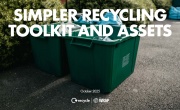ZWS: Single-use vapes could be recharged up to 500 times if redesigned
A Zero Waste Scotland (ZWS) review commissioned by the Scottish Government has found that the lithium polymer batteries used in some of the most popular single-use vapes and other e-cigarettes could be recharged 500 times if the product allowed for such.
 The review aims to establish the environmental impact and potential policy options for improving the management of single-use e-cigarettes.
The review aims to establish the environmental impact and potential policy options for improving the management of single-use e-cigarettes.
Vapes and single-use e-cigarettes have the potential to impact the environment through littering, risks associated with unsafe disposal of their contents including lithium batteries and chemicals, and greenhouse gas emissions and water consumption generated in their manufacture.
The review estimates that in 2022, 10.8 per cent of the adult population of Scotland were regular users of e-cigarettes and of these, more than a quarter (27 per cent) were users of single-use e-cigarettes. The total emissions associated with single-use vapes in 2022 were estimated to be between 3375 and 4292 tonnes CO2e.
On top of this, in 52 weeks leading up to early April 2023, the number of single-use vapes consumed in Scotland was estimated to be between 21 and 26 million units.
The disposal of e-cigarette packaging also has an environmental impact. The annual weight of packaging and materials discarded as a result of single-use e-cigarette consumption in Scotland is currently between 800 and 1,000 tonnes.
Bans and eco-design for single-use vapes
This report recommends a shortlist of nine high-level potential policy options to be considered further by Ministers, from which the Scottish Government may prioritise further policy work to address these environmental impacts.
The policies fall into three categories: clarifying eco-design criteria in existing legislation; a ban on single-use e-cigarettes, and ‘other policies’. Each looks at achieving two objectives:
- Improving management of single-use e-cigarettes,and, enhancing the safe recycling of discarded products;
- And reducing the negative impact of single-use e-cigarettes.
Under the clarifying eco-design criteria, the review suggests setting specific design criteria for e-cigarettes and/or requiring that batteries can not only be removed but can also be replaced – with the durability of the product being able to outlive the battery.
A ban on single-use e-cigarettes is recommended as a joint agreement between all four nations of the UK which considers the possible consequence of consumers switching to e-cigarettes that make use of replaceable pre-filled containers of liquids.
Alternatively, a Scotland-only ban would need to consider legislation to discourage cross-border movement, and re-selling.
Other policy options for single-use vapes
Other policies make the assumption that no ban or clarification on eco-design is in place. There are six policy options (options four to nine in the review) which ZWS says could be used as a package of complementary measures.
Firstly, option four suggests charging a deposit for single-use e-cigarettes which can be redeemed upon return or recycling of the product. One of the advantages of charging a deposit in this context is that if existing WEEE Regulations and associated take-back requirements were complied with, take-back systems would already be in place in a number of locations.
Option five looks at the potential for a tax linked to recycling rates in the context that a deposit return scheme (DRS) or similarly incentivised scheme for e-cigarettes is in place. The review predicts that a sufficiently large tax incentive could increase the likelihood of the industry adopting an approach that delivers very high recycling rates.
Following this, the review advises that a comprehensive change in the obligations and categories within the current WEEE Regulations may deliver on both objectives – although its impact on littering may not be as great as a DRS for e-cigarettes. This option extends the scope of cost recovery to include litter clean up, introduces a separate WEEE category for e-cigarettes, ensures that the costs of management of e-cigarettes are borne by the producers of them, and includes setting targets for separate collection and for recycling at high levels on e-cigarettes of all types.
Option seven suggests a levy or charge on sales payable by the consumer which is designed to shift consumption away from single-use e-cigarettes and towards e-cigarettes where the user is expected to refill the device with liquid themselves. The levy could be structured so that there are differentials across the types of e-cigarettes, designed so that the highest levy falls on single-use with a lower levy applied to refillable e-cigarettes.
Following success in other regions, the review also proposes a ban on flavoured e-cigarettes. Evidence suggests that such bans can help reduce user numbers, in particular, reduce the number of younger users, and potentially reduce the intensity of use in remaining users. The review acknowledges that this could be problematic as it may encourage consumers to purchase the products in England and bring them across the border for resale.
Finally, ZWS suggests an overall tightening of enforcement of existing law in relation to underage sales – which should be considered a matter of urgency given that underage users are the main users of single-use cigarettes.
The review concludes that a more detailed consideration and analysis should be taken ahead of a final decision. There is an ongoing four-nation review of current WEEE regulations and given the high degree of public concern regarding single-use vapes, it's likely that England, Wales and Northern Ireland will also be considering potential policy options around e-cigarettes. 







